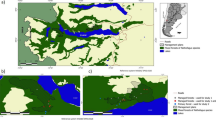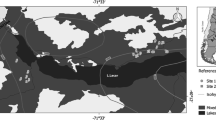Abstract
We used an integrated approach to analyze the influence of silvopastoral management on the biotic and abiotic factors influencing on the natural recruitment of native forests in Tierra del Fuego (Argentina). The probabilities of transition from flowers to seeds to seedlings were estimated in forests with silvopastoral management (i.e., stands that had been both grazed and thinned), secondary growth stands, and unmanaged old-growth areas. Pre-dispersal losses were caused by microclimate and insect predation acting on flowers and immature fruits. Post-dispersal losses resulted from the impact of reduced litterfall and microclimate. But the most critical stage of the overall cycle was seedling establishment. Silvopastoral practices and stand age modified the main drivers of regeneration. While flowering was unaffected by management, fruiting and seed production were more successful in unmanaged forests. Seedling establishment and survival were favored by canopy cover reduction in silvopastoral stands. The increase of solar radiation and soil moisture in managed forests positively influenced the seedling establishment and survival, while in second-growth forests it was limited by suitable micro-site availability. Thinning practices aimed at increasing the understory heterogeneity in mature forests and restoring canopy complexity of second-growth stands could be suitable for sustainable management of these temperate forests.



Similar content being viewed by others
References
Adler PB, Raff DA, Lauenroth WK (2001) The effect of grazing on the spatial heterogeneity of vegetation. Oecologia 128:465–479
Báez P, Riveros M, Lehnebach C (2002) Viability and longevity of pollen of Nothofagus species in South Chile. NZ J Botany 40:671–678
Bahamonde H, Peri PL, Martinez Pastur G, Lencinas MV (2009) Variaciones microclimáticas en bosques primarios y bajo uso silvopastoril de Nothofagus antarctica en dos Clases de Sitio en Patagonia Sur. Proceedings of the 1st National Congress of Silvopastoral Systems, Misiones, Argentina. INTA, pp 289–296
Bahamonde HA, Peri PL, Monelos LH, Martínez Pastur G (2011) Aspectos ecológicos de la regeneración por semillas en bosques nativos de Nothofagus antarctica en Patagonia Sur, Argentina. Bosque 32:20–29
Bitterlich W (1984) The relascope idea. Relative measurements in forestry, Commonwealth Agricultural Bureaux
Burgos A, Grez AA, Bustamante RO (2008) Seed production, pre-dispersal seed predation and germination of Nothofagus glauca (Nothofagaceae) in a temperate fragmented forest in Chile. For Ecol Manage 255:1226–1233
Caldentey J, Ibarra M, Hernández J (2001) Litter fluxes and decomposition in Nothofagus pumilio stands in the region of Magallanes, Chile. For Ecol Manage 148:145–157
Clark JS, Beckage B, Camill P, Cleveland B, Hillerislambers J, Lichter J, Mclachlan J, Mohan J, Wyckoff P (1999) Interpreting recruitment limitation in forests. Am J Botany 86:1–16
D’Amato AW, Orwig DA, Foster DR (2009) Understory vegetation in old-growth and second-growth Tsuga canadensis forests in western Massachusetts. For Ecol Manage 257:1043–1052
Deferrari G, Camilión C, Martínez Pastur G, Peri P (2001) Changes in Nothofagus pumilio forest biodiversity during the forest management cycle: birds. Biodiv Conserv 10:2093–2108
Donoso C, Steinke L, Premoli A (2006) Nothofagus antarctica (G. Forster) Oerst., ñire, ñirre, ñiré, anis (Tierra del Fuego), Ñirre: de Ñgërü (mapudungun): zorro. In: Donoso C (ed) Las especies arbóreas de los bosques templados de Chile y Argentina: Autoecología, 1st edn. Marisa Cuneo Ediciones, Valdivia, pp 411–422
García Castaño JL, Kollmann J, Jordano P (2006) Spatial variation of post-dispersal seed removal by rodents in highland microhabitats of Spain and Switzerland. Seed Sci Res 16:213–222
Gregory NG (1995) The role of shelterbelts in protecting livestock: a review. NZJ Agric Res 38:423–450
Grimmond CSB, Robeson SM, Schoof JT (2000) Spatial variability of micro-climatic conditions within a mid-latitude deciduous forest. Clim Res 15:137–149
Heinemann K, Kitzberger T, Veblen T (2000) Influences of gap microheterogeneity on the regeneration of Nothofagus pumilio in a xeric old-growth forest of northwestern Patagonia, Argentina. Can J For Res 30:25–31
Ivancich H, Martínez Pastur G, Lencinas MV, Soler Esteban R, Peri P (2012) Respuesta del canopeo y crecimiento de Nothofagus antarctica bajo manejo silvopastoril. Proceedings of the 2nd National Congress of Silvopastoral Systems, Santiago del Estero, Argentina. INTA, pp 270–275
Jordano P (2000) Fruits and frugivory. In: Fenner M (ed) Seeds: the ecology of regeneration in natural plant communities. Commonwealth Agricultural Bureau International, Wallingford, pp 125–166
Jose J (2009) Agroforestry for ecosystem services and environmental benefits: an overview. Agrofor Syst 76:1–10
Kelt DA, Meserve PL, Lang BK (1994) Quantitative habitat associations of small mammals in a temperate rainforest in Southern Chile: empirical patterns and the importance of ecological scale. J Mammal 75:890–904
Lencinas MV, Martínez Pastur G, Cellini JM, Vukasovic R, Peri PL, Fernández C (2002) Incorporación de la altura dominante y la calidad de sitio a ecuaciones estándar de volumen para Nothofagus antarctica (Forster f.) Oersted. Bosque 23:5–17
Lencinas MV, Martínez Pastur G, Gallo E, Cellini JM (2009) Alternative silvicultural practices with variable retention improve bird conservation in managed South Patagonian forests. For Ecol Manage 258:472–480
Lencinas MV, Martínez Pastur G, Gallo E, Cellini JM (2011) Alternative silvicultural practices with variable retention to improve understory plant diversity conservation in southern Patagonian forests. For Ecol Manage 262:1236–1250
Martínez Pastur G, Lencinas MV, Peri PL, Cellini JM (2008) Flowering and seeding patterns in unmanaged and managed Nothofagus pumilio forests with a silvicultural variable retention system. Forstarchiv 79:60–65
Martínez Pastur G, Cellini JM, Lencinas MV, Barrera M, Peri PL (2011) Environmental variables influencing regeneration of Nothofagus pumilio in a system with combined aggregated and dispersed retention. For Ecol Manage 26:178–186
Martínez Pastur G, Soler Esteban RM, Pulido F, Lencinas MV (2013) Variable retention harvesting influences biotic and abiotic drivers of regeneration in Nothofagus pumilio southern Patagonian forests. For Ecol Manage 289:106–114
Montes C, De Lamo DA, Zavatti J (2000) Distribución de abundancias de guanacos (Lama guanicoe) en los distintos ambientes de Tierra del Fuego, Argentina. J Neotrop Mammal 7:23–31
Moore RP (1985) Handbook on tetrazolium testing. International Seed Testing Association, Zurich
Ormaechea S, PL Peri, R. Molina, JP Mayo (2009) Situación y manejo actual del sector ganadero en establecimientos con bosque de ñire (Nothofagus antarctica) de Patagonia sur. Proceedings of the 1st National Congress of Silvopastoral Systems, Misiones, Argentina. INTA, pp 385–393
Peri PL (2009) Relevamiento de los bosques nativos de ñire (Nothofagus antarctica) de Tierra del Fuego (Argentina) como herramienta para el manejo sustentable. INTA, Buenos Aires
Peri PL, Gargaglione V, Martínez Pastur G (2008) Above- and below-ground nutrients storage and biomass accumulation in marginal Nothofagus antarctica forests in Southern Patagonia. For Ecol Manage 255:2502–2511
Peri PL, Hansen N, Rusch V, Tejera L, Monelos L, Fertig M, Bahamonde H, Sarasola M (2009a) Pautas de manejo de sistemas silvopastoriles en bosques nativos de Nothofagus antarctica (ñire) en Patagonia Proceedings of the 1st National Congress of Silvopastoral Systems, Misiones, Argentina. INTA, pp 151–164
Peri PL, Martínez Pastur G, Lencinas MV (2009b) Photosynthetic response to different light intensities and water status of two main Nothofagus species of southern Patagonian forest, Argentina. J For Sci 55:101–111
Premoli A (1991) Morfología y capacidad germinativa en poblaciones de Nothofagus antarctica (Forster) Oerst del noroeste andino patagónico. Bosque 12:53–59
Promis A, Caldentey J, Ibarra M (2010) Microclima en el interior de un bosque de Nothofagus pumilio y el efecto de una corta de regeneración. Bosque 31:129–139
Pulido F, García E, Obrador JJ, Moreno G (2010) Multiple pathways for tree regeneration in anthropogenic savannas: incorporating biotic and abiotic drivers into management schemes. J Appl Ecol 47:1272–1281
Ratajczak E, Pukacka S (2005) Decrease in beech (Fagus sylvatica) seed viability caused by temperature and humidity conditions as related to membrane damage and lipid composition. Acta Physiol Plant 27:3–12
Riveros M, Paredes M, Rosas M, Cárdenas E, Armesto J, Arroyo MTK, Palma B (1995) Reproductive biology in species of the genus Nothofagus. Environ Exp Bot 35:519–524
Roig FA (1998) La vegetación de la Patagonia. In: Correa M (ed) Flora Patagónica. INTA, Buenos Aires, pp 1–174
Romanya J, Fons J, Sauras Yera T, Gutiérrez E, Vallejo VR (2005) Soil-plant relationships and tree distribution in old growth Nothofagus betuloides and Nothofagus pumilio forests of Tierra del Fuego. Geoderma 124:169–180
Sánchez-Jardón L, Acosta B, del Pozo A, Casado MA, Ovalle C, Elizalde HF, Hepp C, de Miguela JM (2010) Grassland productivity and diversity on a tree cover gradient in Nothofagus pumilio in NW Patagonia. Agric Ecosyst Environ 137:213–218
Seltmann P, Leyer I, Renison D, Hensen I (2007) Variation of seed mass and its effects on germination in Polylepis australis: implications for seed collection. New Forest 33:171–181
Soler R (2012) Regeneración natural de Nothofagus antarctica en bosques primarios, secundarios y bajo uso silvopastoril. PhD Thesis, University of Córdoba, p 144
Soler R, Martínez Pastur G, Lencinas MV, Peri PL (2010) Flowering and seeding patterns in primary, secondary and managed Nothofagus antarctica South Patagonian forests. NZJ Bot 48:63–73
Soler R, Martínez Pastur G, Lencinas MV, Borrelli L (2012) Differential forage use between large native and domestic herbivores in Southern Patagonian Nothofagus forests. Agrofor Syst 85:397–409
Spagarino C, Martínez Pastur G, Peri P (2001) Changes in Nothofagus pumilio forest biodiversity during the forest management cycle: insects. Biodiv Conserv 10:2077–2092
Steinke LR, Premoli AC, Souto CP, Hedrén M (2008) Adaptive and neutral variation of the resprouter Nothofagus antarctica growing in distinct habitats in northwestern Patagonia. Silva Fennica 42:177–188
Stenburg P, Linder S, Smolander H, Flower Ellis J (1994) Performance of the LAI-2000 plant canopy analyzer in estimating leaf area index of some Scots pine stands. Tree Physiol 14:981–995
Stephenson AG (1981) Flower and fruit abortion: proximate causes and ultimate functions. Annu Rev Ecol Syst 12:253–279
Sullivan J, Burrows C, Dugdale J (1995) Insect predation of seeds of native New Zealand woody plants in some central South Island localities. NZJ Bot 33:355–364
Ueda A (2000) Pre- and post-dispersal damage to the nuts of two beech species (Fagus crenata Blume and F. japonica Maxim.) that masted simultaneously at the same site. J For Res 5:21–29
Acknowledgments
We are grateful to Kareken Sawmill (Tierra del Fuego) for providing logistic support during fieldwork. Many thanks to J. Escobar, H. Ivancich, M. Cellini, G. Kreps, M. Barrera, and R. Vukasovič for their collaboration in data collection in the forests. Thanks also to S. M. Rivera and M. Villareal (Universidad Nacional de La Plata) for their helpful observations and discussions on flowering biology, C. B. Anderson for language revision and improvements to the manuscript.
Author information
Authors and Affiliations
Corresponding author
Rights and permissions
About this article
Cite this article
Soler, R., Pastur, G.M., Peri, P. et al. Are silvopastoral systems compatible with forest regeneration? An integrative approach in southern Patagonia. Agroforest Syst 87, 1213–1227 (2013). https://doi.org/10.1007/s10457-013-9631-z
Received:
Accepted:
Published:
Issue Date:
DOI: https://doi.org/10.1007/s10457-013-9631-z




